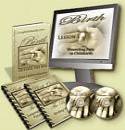Stage III: Placenta Delivery
The third stage, the placenta delivery, is fairly anticlimactic for most. However, there are two critical events to avoid prevent in the placenta delivery stage: early cord clamping and manual cord traction.
Once the baby is born, you are so delighted and overwhelmed with its presence and the emotional high you experience that it can be easy to miss the cord being early clamped. Since this is misguided routine procedure in most hospitals, the best prevention is to make your wishes clear to your provider in advance of the birth. Even so, many will forget and habit will take over. The birth companion may need to remind the care provider during labor of your wishes to prevent the cord from being early clamped.
Manual cord traction occurs when the care provider decides to "help" the placenta detach quickly by pulling on the cord. This confers no benefit to the mother and increases the risk of postpartum hemorrhage, which is the leading complication noted in childbirth. In some cases of postpartum hemorrhage, mothers will thank their doctors for "saving them" from bleeding to death, never realizing it was the doctor's own actions that caused the hemorrhage. They swear that they would have died if they hadn't been in a hospital when the actual complication was completely preventable.
Sometimes the placenta delivery is delayed. Nursing the baby will help stimulate contractions to expel the placenta, because it releases natural oxytocin into the body. Coughing, sneezing and laughing can be also be used. Even a good hard cry to celebrate your baby's birth can do the trick.
WHAT & HOW YOU MAY FEEL
- Indescribable Joy
- Empowered
- A Birthing "High"
- Afterbirth sensations or contractions
- Uncontrollable Shaking
BEHAVIOR & ATTITUDE
- Tears of Joy
- Uncontrollable Smiling
MANAGEMENT STRATEGIES
The placenta delivery doesn't need much management. After a few hours, you might find that the afterbirth pangs require some breathing and relaxation techniques as your uterus begins to contract back down to its normal size. Nursing is the best way to naturally stop postpartum bleeding, called lochia, by helping the uterus contract. Fundal massage, where a care provider presses on your uterus, can also be performed to slow bleeding and break up any clots. However, this can be uncomfortable depending on the force used. Nursing is more effective but if fundal massage is recommended, then you can ask someone to instruct you on how to perform it, and then do it yourself.
WHAT YOU MIGHT DO
- Cry
- Request Immediate Contact with the Baby
- Nurse Immediately
- Delay Newborn Procedures
WHAT YOUR Birth COMPANION MIGHT DO
- Stay with You
- Hold the Baby
- Take Pictures
- Make a Video
It is common to experience uncontrollable shaking after the placenta delivery. This is just the body's normal reaction to the hormonal changes that take place after birth. It can sometimes interfere with your ability to hold your baby. It usually lasts only a few minutes and wrapping yourself with blankets from a warmer will help keep you comfortable until it subsides.
After the placenta delivery, you may wish to see or keep it. Some hospitals will sell your placenta if you don't claim it. If you do not wish medical research to be performed on your placenta, then tell your care provider you want to dispose of it yourself.
Planting the placenta is one option. Dig a hole at least 16 inches deep and bury the placenta. You must wait a year before trying to plant a tree or anything over it because it will be too rich and may kill the plant. You can save the planting for your baby's first birthday.
References
Rabe H, Reynolds G, Diaz-Rossello J. Early versus delayed umbilical cord clamping in preterm infants. Cochrane Database of Systematic Reviews 2004, Issue 4. Art. No.: CD003248. DOI: 10.1002/14651858.CD003248.pub2.Prendiville WJ, Elbourne D, McDonald S. Active versus expectant management in the third stage of labour. Cochrane Database of Systematic Reviews 2000, Issue 3. Art. No.: CD000007. DOI: 10.1002/14651858.CD000007.
Cotter A, Ness A, Tolosa J. Prophylactic oxytocin for the third stage of labour. Cochrane Database of Systematic Reviews 2001, Issue 4. Art. No.: CD001808. DOI: 10.1002/14651858.CD001808.
Return from Placenta Delivery to Stages of Labor
Return to Giving Birth Naturally Home
Page Last Modified by Catherine Beier, MS, CBE
Most Popular
How to Use Acupressure to Induce Labor
Childbirth Relaxation Script MP3s
Nutrition During Pregnancy - Nix the Notion of Eating for Two
Looking for a Birth Professional? Search our Provider Directory
Online Childbirth Classes
Choose 7 week, 12 week, or Self- Paced online childbirth classes available wherever and whenever you need them.
Featured Birth Story
Vanessa's natural birth story shows that when birth is left alone to proceed as it should, it waits for no one - not even doctors or midwives.
Free Pregnancy Tickers
Create a free pregnancy ticker to post on your blog, website, Facebook profile or favorite social media...




